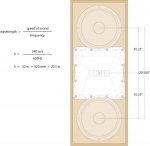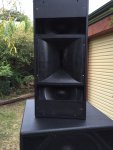Re: Double 10 and Horn
Hi Boyd,
The double 12 actually came about because everyone loved the double 10, but they wanted more power. Often they were requesting 2 boxes a side ... which was is not the best solution.
... So I set out to build another box with 6 dB more output. With the DIY double 12 I think I ended up with more like 10dB.
Anyway … I did think of putting another two 10 inch speakers on top of the double 10 like you are suggesting, but ultimately I thought the double 12 was a better solution.
When I have a moment I should try your suggestion. FWIW I have actually flown them two deep – it seemed to work OK.
Have you considered an additional 2x 10" module that could be attached to the top of the dbl 10"+horn for higher output applications? Seems to me like it could result in an arrangement similar to your dual 12" horn (assuming the dual 10" sections would play together happily at that separation & crossover freq), and could probably be tested quite easily by stacking another cab on top, and driving only the 10"s in the top cab, and boosting the HF/VHF (c2c would be a bit more for the top cab, but if it works, customised cabs could make it work even better). Just a thought :razz:
Hi Boyd,
The double 12 actually came about because everyone loved the double 10, but they wanted more power. Often they were requesting 2 boxes a side ... which was is not the best solution.
... So I set out to build another box with 6 dB more output. With the DIY double 12 I think I ended up with more like 10dB.
Anyway … I did think of putting another two 10 inch speakers on top of the double 10 like you are suggesting, but ultimately I thought the double 12 was a better solution.
When I have a moment I should try your suggestion. FWIW I have actually flown them two deep – it seemed to work OK.



